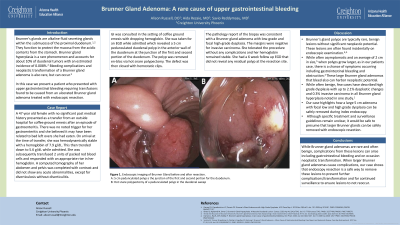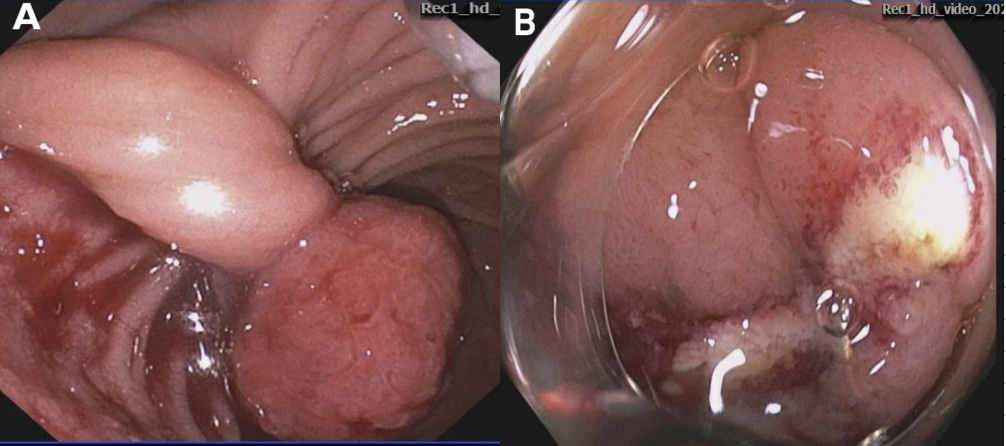Tuesday Poster Session
Category: Small Intestine
P4975 - Brunner Gland Adenoma: A Rare Cause of Upper Gastrointestinal Bleeding
Tuesday, October 29, 2024
10:30 AM - 4:00 PM ET
Location: Exhibit Hall E

Has Audio

Alison Russell, DO
Creighton University Medical Center
Scottsdale, AZ
Presenting Author(s)
Alison Russell, DO1, Aida Rezaie, MD2, Savio Reddymasu, MD3
1Creighton University School of Medicine, Scottsdale, AZ; 2Creighton University School of Medicine, Mesa, AZ; 3Creighton University School of Medicine, Phoenix, AZ
Introduction: Brunner’s glands are alkaline fluid secreting glands in the submucosa of the proximal duodenum to protect the mucosa from acidic contents from the stomach. Brunner gland hyperplasia is rare and accounts for about 10% of duodenal tumors with an estimated incidence of 0.008%. Bleeding and neoplastic transformation of Brunner gland adenoma is rare. We present a patient with upper gastrointestinal bleeding from an ulcerated Brunner gland adenoma treated with endoscopic resection.
Case Description/Methods: A 47-year-old female with no significant past medical history presented with coffee ground emesis after an episode of gastroenteritis. On arrival, she was hemodynamically stable with hemoglobin of 7.9 g/dl which down-trended to 5.6, g/dL. She was subsequently transfused 2 units of packed red blood cells and responded appropriately. Computed tomography of her abdomen and pelvis with IV contrast did not show any acute abnormalities except for diverticulosis. EGD revealed a 5 cm pedunculated duodenal polyp in the anterior wall of the duodenum at the junction of the first and second portion of the duodenum. The polyp was removed en-bloc via hot snare polypectomy and the defect was closed with hemostatic clips. Pathology was consistent with a Brunner gland adenoma with low-grade and focal high-grade dysplasia. The margins were negative for invasive carcinoma. Patient did not have post procedure complications and her 6 week follow up EGD did not reveal residual polyp at the polypectomy site.
Discussion: Brunner’s gland polyps are typically rare, benign lesions without significant neoplastic potential. We present a unique case of upper gastrointestinal bleeding from a Brunner’s gland adenoma with focal low- and high-grade dysplasia. The lesions that bleed and harbor neoplastic potential tend to be quite large. This case highlights the fact that these lesions can be safely removed during index endoscopy irrespective of the size. Although specific treatment and surveillance guidelines remain unclear, it would be safe to presume that larger Brunner gland appearing polyps can be safely removed by endoscopic resection.

Disclosures:
Alison Russell, DO1, Aida Rezaie, MD2, Savio Reddymasu, MD3. P4975 - Brunner Gland Adenoma: A Rare Cause of Upper Gastrointestinal Bleeding, ACG 2024 Annual Scientific Meeting Abstracts. Philadelphia, PA: American College of Gastroenterology.
1Creighton University School of Medicine, Scottsdale, AZ; 2Creighton University School of Medicine, Mesa, AZ; 3Creighton University School of Medicine, Phoenix, AZ
Introduction: Brunner’s glands are alkaline fluid secreting glands in the submucosa of the proximal duodenum to protect the mucosa from acidic contents from the stomach. Brunner gland hyperplasia is rare and accounts for about 10% of duodenal tumors with an estimated incidence of 0.008%. Bleeding and neoplastic transformation of Brunner gland adenoma is rare. We present a patient with upper gastrointestinal bleeding from an ulcerated Brunner gland adenoma treated with endoscopic resection.
Case Description/Methods: A 47-year-old female with no significant past medical history presented with coffee ground emesis after an episode of gastroenteritis. On arrival, she was hemodynamically stable with hemoglobin of 7.9 g/dl which down-trended to 5.6, g/dL. She was subsequently transfused 2 units of packed red blood cells and responded appropriately. Computed tomography of her abdomen and pelvis with IV contrast did not show any acute abnormalities except for diverticulosis. EGD revealed a 5 cm pedunculated duodenal polyp in the anterior wall of the duodenum at the junction of the first and second portion of the duodenum. The polyp was removed en-bloc via hot snare polypectomy and the defect was closed with hemostatic clips. Pathology was consistent with a Brunner gland adenoma with low-grade and focal high-grade dysplasia. The margins were negative for invasive carcinoma. Patient did not have post procedure complications and her 6 week follow up EGD did not reveal residual polyp at the polypectomy site.
Discussion: Brunner’s gland polyps are typically rare, benign lesions without significant neoplastic potential. We present a unique case of upper gastrointestinal bleeding from a Brunner’s gland adenoma with focal low- and high-grade dysplasia. The lesions that bleed and harbor neoplastic potential tend to be quite large. This case highlights the fact that these lesions can be safely removed during index endoscopy irrespective of the size. Although specific treatment and surveillance guidelines remain unclear, it would be safe to presume that larger Brunner gland appearing polyps can be safely removed by endoscopic resection.

Figure: Title: Endoscopic imaging of Brunner Gland before and after resection
A: 5cm pedunculated polyp at the junction of the first and second portion of the duodenum
B: Hot snare polypectomy of a pedunculated polyp in the duodenal sweep
A: 5cm pedunculated polyp at the junction of the first and second portion of the duodenum
B: Hot snare polypectomy of a pedunculated polyp in the duodenal sweep
Disclosures:
Alison Russell indicated no relevant financial relationships.
Aida Rezaie indicated no relevant financial relationships.
Savio Reddymasu indicated no relevant financial relationships.
Alison Russell, DO1, Aida Rezaie, MD2, Savio Reddymasu, MD3. P4975 - Brunner Gland Adenoma: A Rare Cause of Upper Gastrointestinal Bleeding, ACG 2024 Annual Scientific Meeting Abstracts. Philadelphia, PA: American College of Gastroenterology.
